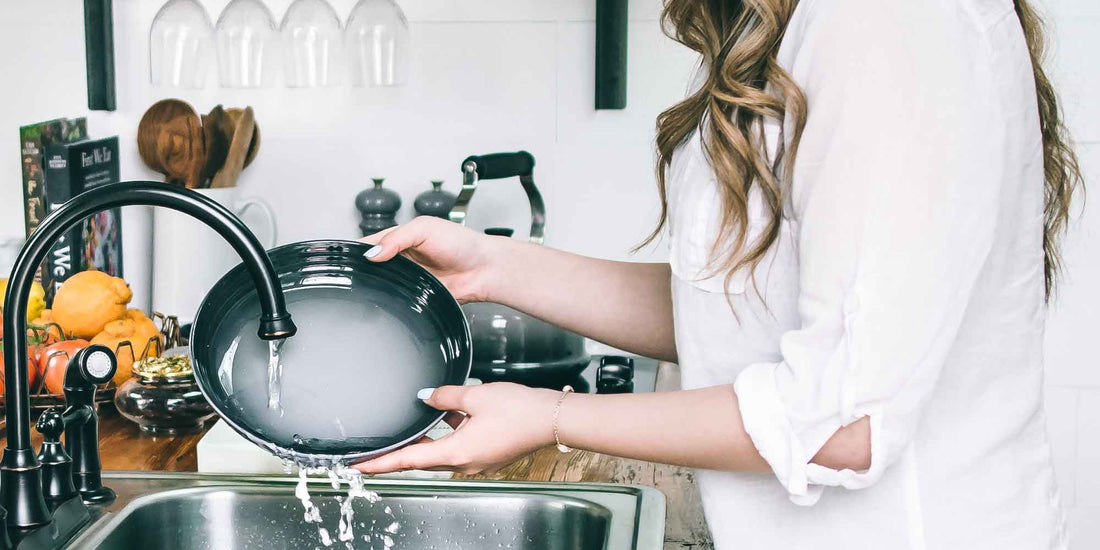
How to clean a burnt pot or pan without damaging It
The cool weather is settling in and the holidays are fast approaching. For many, this means pots and pans on overdrive preparing warm, hearty meals for celebrations and for comfort in the cold. Unfortunately, the slightest miscalculation of timing or ingredients can lead to a burnt pot, and cleaning it incorrectly can make matters worse. Learn how to clean a burnt pot or pan without damaging it by following the steps below.

BEFORE YOU TRY TO CLEAN A SCORCHED PAN…
Remember that removing the burns is not your only goal. You also want to preserve the surface of your cookware and keep your food safe by using cleaners that don't contain harmful chemicals that can leave toxic residues in your kitchen.
Kitchen cleaning products designed for 'heavy duty' grease or burn removal often rely too heavily on toxics to remove the burns chemically. Only 6% of household kitchen cleaners are rated “A” by the Environmental Working Group (EWG). This means that the available information for 32% of kitchen cleaning products indicates a health hazard. Natural cleaning products, some time, and a good scrub should work in most cases and won't expose you to harsh chemicals.
TOOLS FOR CLEANING BURNT POTS & PANS
- A non-abrasive, natural scouring powder like the AspenClean Natural Scouring Powder
- Eco friendly Dish Soap
- A cloth scrubber or steel wool – cloth scrubbers are good for scrubbing without leaving marks on ceramic casserole dishes
- A tub or sink for soaking
- Small bowl and mixing spoon
STEPS FOR CLEANING BURNT IN POTS & PANS
To remove burnt-on food or thick greasy build-up follow these steps.
SOAK THE DISHES
- Fill a sink or tub with hot water mixed with a little dish soap.
- Ensure the pots and pans can be fully submerged in soapy water.
- Leave for at least half an hour – the longer you leave them to soak, the easier it will be to remove the mess later. Using a tub will keep your sink free for use while the pots are soaking.
- TIP: If you have time, you can also boil a mix of water and some white vinegar in the charred pot or pan as soon as you notice the burn. Do this in place of soaking to really loosen up the soil before there it cools and cakes on. Create a Scrubbing Paste

CREATE A SCRUBBING PASTE
- Mix with one tablespoon of water – this should make about a quarter of a cup of paste which should be enough to scrub a moderately burned small pot. You can scale this mix-up or down at a ratio of 2:1 depending on how dirty your pots are and how many there are to clean.
SCRUB THE POTS
- Drain the soapy water from the sink or remove your pot from the tub.
- Rise and wipe any debris that has loosened after soaking.
- Dab a generous amount of paste onto the mess that remains on the pot.
- Leave for about five minutes to allow the solution to work.
- Use a little elbow grease to scrub the mess off.
- Feel for any mess that you may have missed.
- Repeat this step if necessary.
FINAL WASH
- After the caked-on mess has been lifted, wash the pots and pans using natural dish soap by hand, or in the dishwasher as normal to remove grease

TIPS FOR PREVENTING BURNT PANS AND POTS
Even the most careful cooks will be surprised with a burn every now and again. To prevent burns, ensure you adequately grease your trays and casseroles, use baking paper and keep stirring your pot.
Perfluorooctanoic acid (PFOA) was commonly used in non-stick cookware such as Teflon. However, it has since been linked to numerous adverse health conditions and is now considered a suspected carcinogen and hormone disruptor. The use of PFOAs is being phased out, however, to stay on the safe side try and use ceramic, cast-iron, or regular stainless steel pots and pans where possible. You should have no issues cleaning these alternatives with the right natural cleaners.